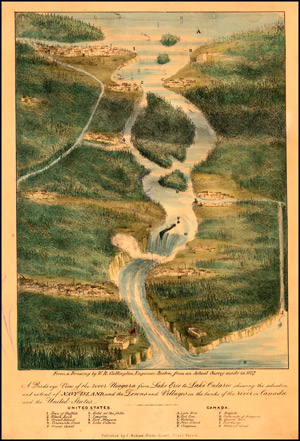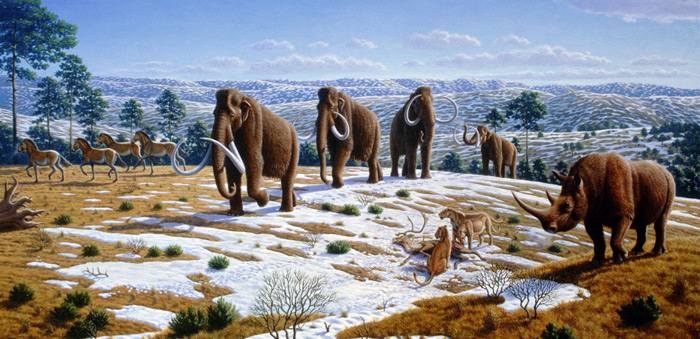Hole in the Clouds
Sep 11, 2009
The Great Lakes are basically big puddles that filled with meltwater after the last Ice Age; to this day, almost all the rivers that feed the lakes come in from the north, where the glaciers used to be.
We could think of the Great Lakes as five bowls set on a staircase, each bowl brimming over and cascading down into the next. By the time the water slops over from the fourth bowl--Lake Erie--down to the last one--Lake Ontario--it's really spilling seriously, all fast and furious. And so we have Niagara Falls: an entire Ice Age of fossil water, draining down through four Great Lakes and then crashing hard through a narrow little riverbed to splash into that one last lake and then the St. Lawrence River and finally the Atlantic Ocean.
When European explorers first glimpsed Niagara, its connection to the two huge lakes seemed obvious and dramatic. This 1837 bird's eye view puts Lake Erie at the top, the falls in the middle, and Lake Ontario at the bottom of the picture, collecting all that splashover from ten thousand years of melting ice.

New York
Niagara Falls
Lake Ontario
Lake Erie
ice age
Canada
(Image credit: W.R. Callington)
Jan 29, 2016

 This time of year, alas, our thoughts turn to Siberia, or to the Ice Ages, or even to Siberia during the Ice Ages, when woolly mammoths were walking tall and cave lions commanded the countryside.
This time of year, alas, our thoughts turn to Siberia, or to the Ice Ages, or even to Siberia during the Ice Ages, when woolly mammoths were walking tall and cave lions commanded the countryside.
Last summer, two men digging for mammoth tusks along a riverbank in Yakutia, eastern Siberia, came across a couple of brown and furry-looking chunks of ice about the size of household cats. Not sure what they were but hoping they might be worth something to somebody, the men kept the things from thawing out by reburying them deep in the permafrost. In September, they returned with scientists from the institute in Yakutsk and learned that they'd found the corpses of two baby cave lions.
Cave lions are an extinct subspecies of lion that ranged across all of Eurasia, from Spain to Siberia, and crossed the land bridge to North America during the Ice Ages. They've been extinct for 12,000 years or more, but they are well known to us through the work of numerous prehistoric artists who featured them in paintings on the walls of caves.
Cave lions did not themselves live in caves, but of course their babies stayed in dens when they were small, and these particular cubs were still very young when, it is theorized, their den caved in on them, perhaps in connection with a landslide. Buried deep in rubble, the cubs probably died from lack of oxygen, which also helped preserve their corpses so well for thousands of years.
The top photo is an artist's rendering of a snowy landscape with mammoths, cave lions, a woolly rhinoceros, and other Ice Age critters; the scene is said to be set in northern Spain.
Below that is one of the Siberian cave lion cubs, resting on a block of ice.
In the photo at the bottom of this post, a scientist takes off one of his gloves and sticks his finger in the cub's mouth. His actions may strike us as a bit casual and unscientific, though there is some research happening here: by feeling for the nubs of baby teeth in the cub's gums, he was able to estimate its age as approximately two weeks. These same scientists have announced their intention to clone these cubs, in hopes of bringing back the extinct species. We'll keep you posted.

ice age
Siberia
baby animals
Yakutia
lions
fossils
mammoths
extinct animals
cave lions
cave art
Yakutsk
Siberian Times)
art by Mauricio Arton; middle and bottom
(Image credits: top


 This time of year, alas, our thoughts turn to Siberia, or to the Ice Ages, or even to Siberia during the Ice Ages, when woolly mammoths were walking tall and cave lions commanded the countryside.
This time of year, alas, our thoughts turn to Siberia, or to the Ice Ages, or even to Siberia during the Ice Ages, when woolly mammoths were walking tall and cave lions commanded the countryside.